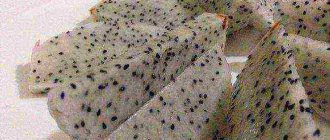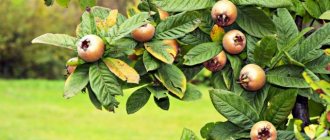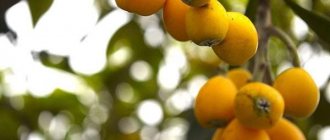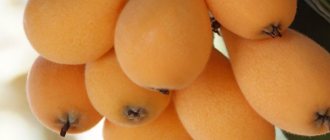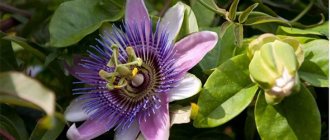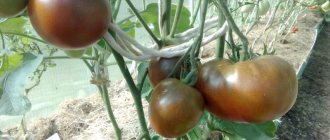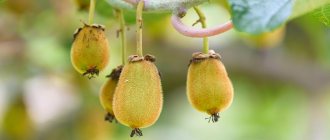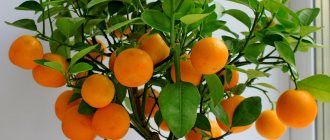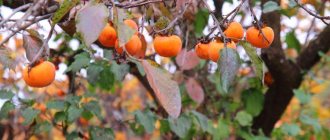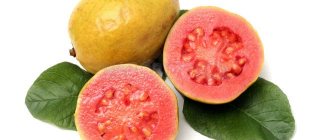Author: Natalya Category: Fruit and berry plants Published: June 23, 2018Republished: February 23, 2019Last edits: November 2, 2020
- Landing in the ground
- Japanese medlar (Eriobotrya japonica)
- Beneficial features
Medlar, or cup tree, or ezgil (lat. Mespilus) is a genus of deciduous plants of the Rosaceae family. According to The Plant List, there are only three species in the genus. The word “loquat” was borrowed from the Turkish language, into which it came from Greek. German medlar, or common medlar, is grown as a cultivated plant; it does not come from Germany, as one might assume, but from South-West Asia and South-Eastern Europe. The medlar was brought to Germany by the Romans. Today, it is found in the wild in Azerbaijan, South Ossetia, Georgia, Armenia, the North Caucasus, on the southern coast of Crimea and even in the central regions of Ukraine. This plant has been grown for more than 3000 years. It was introduced into culture by the ancient Greeks; in the ancient Roman era and the Middle Ages, medlar was already the most important fruit plant. However, then interest in it gradually faded away; it was replaced by other crops, including those imported to Europe from the New World. Nowadays, medlar can be found rarely.
Planting and caring for medlar
- Flowering: late spring or early summer.
- Planting: three-year-old seedlings are planted in the ground in early spring or during leaf fall.
- Lighting: bright light.
- Soil: to fill the planting pit, prepare a mixture of equal parts of turf soil, humus, deciduous soil and sand.
- Watering: as needed, trying to avoid overwatering.
- Feeding: young trees are fed once every 3 weeks, and adults – 2-3 times per season with complex mineral fertilizers or mullein solution.
- Pruning: sanitary cleaning is carried out in early spring, and crown formation begins at the age of four.
- Reproduction: seeds (seeds) and cuttings.
- Pests and diseases: practically not affected.
- Properties: medlar fruits are a valuable dietary product, and a decoction of the leaves of the plant has anti-inflammatory, strengthening and hemostatic properties.
Read more about growing medlar below.
Where does medlar grow?
In the Caucasus, the first mentions of medlar date back to the beginning of the first millennium BC. In Greece, the crop has been grown since the 4th century. The subtropical fruit plant grows in the form of trees or shrubs on the Crimean Peninsula, South Ossetia, Armenia, Azerbaijan, Georgia, the Balkans, the vast expanses of Anatolia and Iran. European gardeners liked the German variety of medlar.
The medlar became most widespread in the Middle Ages. Over time, the culture was replaced by other plants that were brought to Europe from all over the world. Modern gardeners grow it extremely rarely.
Botanical description
The loquat tree is an evergreen fruiting plant covered with dark gray bark that can grow up to eight meters in good conditions, but usually does not exceed six. The dark green elliptical leaves of the medlar reach a length of 8 to 15 and a width of 3-4 cm. In autumn the leaves turn red. In late spring or early summer, white five-petalled flowers open on the tree, attracting pollinating insects with their aroma. The pear-shaped or spherical medlar fruit, 2-3 cm in diameter, with permanent unfolded sepals, is reddish-brown in color and appears hollow. In garden forms, the fruit can reach the size of an average apple. Even after ripening, the medlar fruit remains hard and sour, and the fruits become edible only after long storage or after frost: they wrinkle, become smaller, softer and sweeter.
In the photo: How medlar blooms
How to choose the right one
The fruits should not be eaten immediately after harvest. They should lie in a dark and cool place for some time until they acquire a soft consistency and brown color. The berries that are ideal for consumption have a slightly rotten appearance, which is why many people consider medlar unattractive.
When purchasing, you should choose a lokva:
- large in size, since small berries are very sour and less juicy;
- uniform color without black spots or damage;
- wrinkled but juicy texture.
Before eating medlar, you need to remove the peel and remove the seeds.
Care for medlar at home
Growing from seed
Growing medlar from seed can be done at home. The bone extracted from the pulp is planted no later than three days later. If you purchased medlar seeds in a store, you should understand that a plant grown from them is unlikely to produce a harvest, but medlar from the seed of an eaten fruit will almost certainly bear fruit.
The substrate for medlar can be purchased at the store, or you can make it yourself from equal parts of leaf soil, humus, sand and peat. Fill the pot with drainage holes with the substrate, remembering to first place a layer of expanded clay in it. Medlar seeds are buried 2 cm into moistened soil (up to six seeds can be placed in one pot), after which the surface is covered with film or covered with glass. While waiting for germination, the crops are placed in a warm, bright place, for example, on a windowsill.
- Crowberry (shiksha): properties, cultivation, types
In no earlier than a month, sprouts will appear, and it will be necessary to shade the seedlings from direct sunlight, ventilate the crops daily and remove condensation from the covering so that the plants are not affected by fungal diseases from dampness. When the seedlings grow to 2 cm, the covering is removed from the pot, and the seedlings are kept at a temperature not lower than 18 ºC. If it's summer, place the pot with medlar on the balcony or terrace, protecting the young plants from gusts of wind, drafts and bright sun. Keep the substrate slightly moist by watering it 2-3 times a week.
Once the medlar has sprouted, its growth will be rapid: in a month the seedlings can grow up to 15 cm, and then, so that they do not interfere with each other, they are planted in separate deep containers with a soil mixture of coarse river sand, peat and humus. Weak seedlings may die after transplantation, but nothing can be done about it - natural selection... And large and strong plants will become even larger and stronger.
About another rare but useful plant - goji
Home medlar will bloom only in the third year after transplanting into a separate container at the end of autumn or early winter, and the first fruits may appear by the New Year. You can shape the crown of your home medlar only after flowering, although this is not necessary: you can give the crown a shape, or you can let it look natural, cutting off only thickening, weak, diseased and damaged branches.
What edible varieties are there?
In nature, there are about thirty varieties of medlar. Of all this variety, the edible ones are:
- Champagne. The fruits are pear-shaped, covered with light down, dark yellow in color. Each berry weighs about 50 grams. The variety is characterized by a sweet taste with a slight sour aftertaste, similar to pear or cherry.
- Komun . The fruits of the variety are round and flattened. The skin is bright yellow, with fluff. The fruit pulp is juicy, with a pronounced sweet taste.
- Premier. The fruits of the tree are small, oval, yellow-orange, matte in color. The variety is characterized by a delicate sweet and sour taste.
- Tanaka . One of the types of Japanese medlar. The variety is characterized by large, pear-shaped berries, weighing up to 80 grams. The color of the fruit is yellow-orange. The taste is sweet with slight sourness.
- Morozko. The fruit is characterized by a brown-red color. The berries are large, juicy, fragrant.
The most common are German and Japanese varieties of medlar. The German variety is known to gardeners as Caucasian or ordinary. The plant loves a dry, sunny climate with mild winters and moderate summers. In the French colonies, medlar was used as an ornamental garden plant. The fruits are small - from 2 to 3 cm, dense. The taste of the berries is sour.
Japanese medlar is a tree with a dense crown and large leaves. The culture grows well in sunny or shaded areas. The variety is resistant to short-term frosts, but after severe winters it does not produce a harvest.
To understand the difference between the two most common varieties of medlar, you can look at the comparison table.
| Index | Loquat japonica | Medlar |
| Fruit skin | Soft, bright yellow | Dense, brownish or brown |
| Formation of the ovary | On young stems | On last year's branches |
| Foliage | All year round | Seasonal |
| Leaf plate | Evergreen, lower surface with fluff | Shiny, smooth, changes color to red before falling off |
| Fruit ripening | April May | At the end of autumn |
| Bones | From 1 to 5 | From 4 to 5 |
| Taste of berries | sweet | Sour, tart |
| Pulp | Juicy, soft | Dense, not juicy |
| Frost resistance | Significant | Unexpressed |
Growing loquat in the garden
Landing in the ground
Three-year-old medlar seedlings grown at home from seed can continue to be grown as house plants or can be planted in the garden. Medlar needs well-drained soil, neutral or slightly acidic, and the plant is undemanding to the composition of the soil. Groundwater on the site should lie no higher than one and a half meters below the surface. If you decide to plant several seedlings at once, keep a distance of 4.5 m or more between them.
In the photo: Fruit-bearing medlar tree
Medlar is planted in open ground when it is at rest, that is, in spring or autumn. Clear the area intended for loquat from weeds and dig it up with bone meal. Prepare a soil mixture of equal parts of coarse river sand, turf soil, humus and deciduous soil. Dig holes one third larger than the volume of the root system of the seedling with a ball of earth. Drive a stake into the center of the hole of such a height that it reaches the lower branches of the medlar, transfer the seedling from the pot into the hole and fill the space with soil mixture. As a result of planting, the seedling should be at the same depth at which it grew in the pot. After planting, water the plant generously, and when the water is absorbed and the soil settles, tie the seedling to a stake and mulch the soil around it with a layer of compost or rotted manure 7-8 cm thick so that the mulch does not touch the trunk.
How to take care of the garden
Caring for medlar is not much different from caring for other fruit crops. How to grow medlar in your garden? You will have to water the plant, trying to saturate the soil with moisture, but not to waterlog it. After watering or rain, it is advisable to loosen the soil in the tree trunk circle and remove the weeds that appear there.
- How to plant spirea in a flowerbed
Tips for growing cherries - from planting to a rich harvest
Medlars are fed 2-3 times per season with both mineral and organic fertilizers, but young plants require more frequent feeding: once every 3 weeks. Of all organic fertilizers, the plant prefers mullein solution.
In early spring, before sap flow begins, it is necessary to carry out sanitary cleaning: remove diseased, broken, frostbitten branches that thicken the crown. For the first 3-4 years, you need to shorten the skeletal branches by a third of the growth per outer bud. The branches intertwined inside the crown are cut to 2-3 buds. From the age of four, the crown of the medlar, like the crown of any fruit tree, is formed, and when the formation is completed, the shape is simply maintained by pruning.
Loquat propagation
You already know how to grow medlar from a seed, but this plant can also be propagated vegetatively - by cuttings. To do this, a cutting 15-20 cm long with two nodes is cut from last year's growth, the lower leaves are removed, and the plates of the upper leaves are shortened by a third. They do this in order to reduce moisture evaporation. The sections are powdered with ash, after which the cuttings are planted strictly vertically in a pot with expanded clay and a peat-sand substrate. The cuttings are buried 4-5 cm. After planting, the soil is watered. Caring for cuttings consists of regularly watering the substrate and spraying the cuttings with boiled water. It will take about a month for the medlar to root, and when you are sure that the plant has grown roots, transplant it into the garden. The further development of the seedling may be very slow, but do not despair: if you meet the conditions for growing medlar, sooner or later the cutting will definitely begin to grow.
In the photo: Formation of medlar fruits
Loquat propagation
How to propagate medlar by seeds is described in detail above. This crop can also be propagated by cuttings. To prepare cuttings, you should choose last year's growths. The length of the cuttings should be from 15 to 20 centimeters, and each of them should have 2 nodes. The lower leaf plates must be completely removed, and the upper ones must be shortened by 1/3. This will reduce the amount of evaporated moisture. The cut areas must be treated with wood ash. The cuttings should be planted, placing them strictly vertically. To do this, use pots filled with sand-peat soil and expanded clay. The cutting must be buried 40–50 mm into the soil mixture. Planted cuttings need abundant watering. When caring for cuttings, they need to be provided with systematic watering, and they also need to be regularly moistened from a sprayer with pre-boiled water. The cuttings will take root within 4 weeks. After the roots grow, the plant is planted in a garden plot. After planting, the trees will grow relatively slowly, but there is nothing to worry about. If you do everything correctly and take good care of the medlar, then over time its growth and development will become normal.
Diseases and pests
Loquat is quite resistant to both diseases and pests, but from time to time it can be damaged by leaf-eating caterpillars. How to deal with them? In the spring, you need to collect all the spider web nests from the tree and burn them. During the budding period, the medlar and the soil around it are treated with a seven percent solution of Karbofos or a three percent solution of Nitrafen or Chlorophos. For preventive purposes, medlar twice a year - in early spring and after leaf fall - is sprayed with solutions of Fitoverm (20 g per 10 l of water), Insegar (5 g per 10 l of water) or Lepidocid (25 g per 10 l of water).
When to collect medlar fruits and how to store them
The harvest is harvested at different times. This is determined by the type of tree and area of growth:
- Japanese berry. In Turkey and the southern United States, fruits ripen in March-April, on the Black Sea coast a month later. In June-July - on the South Coast.
The fruits of the Japanese medlar reach condition only on the branch, so they are picked ripe.
Fruits are stored for three to four days in a room or refrigerator.
- The fruits of the Germanic variety are usually picked after the first frost: the fruits soften and are suitable for consumption. If frosts are not expected or the fruits are needed for medicinal purposes, the crop is harvested in November or December, the fruit is poured with saline solution and left in a cool place. After two to three weeks the pulp is tender and tasty. However, the fruits wrinkle and become smaller.
Some people prefer to harvest their medlars gradually, until early spring. Leaves for medicinal use are harvested in August. It is better to choose fruits of any variety that are medium in size and firm, without dark spots.
Types and varieties of medlar
As we have already mentioned, of the three species of the genus, only German medlar, or Caucasian medlar, or Crimean medlar is grown in culture - the plant that we described at the beginning of the article. However, there is also Japanese medlar, or eriobothrya, or loquat, or shesek - a small evergreen ornamental and fruit plant grown both in open and indoor ground. Loquat belongs to the genus Eriobothrya of the Rosaceae family, that is, it is a relative of the German medlar, but in fact is not a medlar.
Japanese medlar (Eriobotrya japonica)
Reaches a height of 8 meters. Both the shoots and inflorescences of the plant are reddish-gray with thick felt pubescence. Oval leathery leaves, glossy on the upper side, sessile or on short petioles, reach a length of 25 and a width of 8 cm. They are also densely pubescent below. White or yellow five-petaled flowers with a diameter of 1-2 cm are collected in terminal paniculate inflorescences. The plant tolerates cold well, and with age its winter hardiness becomes increasingly higher. Of the varieties of medlar (Eriobothrya) Japanese, the most famous are:
- Champagne is a plant with fleecy yellow fruits with delicate pulp;
- Morozko is a variety for growing in a greenhouse or at home, the fruits of which are devoid of astringency;
- Silas is a variety with fruits weighing about 80 g, similar to apricots;
- Tanaka - this plant has pear-shaped fruits, orange-yellow color with pinkish flesh, sweet and sour taste.
In the photo: Japanese medlar (Eriobotrya japonica)
In what areas is it used?
Lokva is a universal product that is used for culinary purposes and folk medicine. Both fruit pulp and flowers and leaves are suitable for this.
In medicine
The plant is used to prepare mixtures and decoctions. Loquat seeds are especially useful and should be used with extreme caution. They contain toxic substances, so they can only be used in processed form to prepare a healing potion. People with heart disease drink coffee made from dried, roasted and ground loqua seeds.
Alcohol tincture will help treat bronchitis and relieve asthma attacks.
Components:
- Alcohol – 100 g
- Medlar – 5 pcs.
- Honey – 2 tbsp.
Cooking method:
- Mash the Chinese plum pulp to a puree consistency.
- Crush the seeds in a mortar.
- Place everything in a jar.
- Pour alcohol and add honey.
- Mix thoroughly and cover with a lid.
- Leave for 3 days.
Take 1 tablespoon before meals. The infusion helps suppress coughing attacks and improves sputum discharge.
In cooking
Medlar is used to make jam, preserves, marshmallows, natural juices and marmalade. It is also added to sauces, sherbet, compotes and fillings when baking pies and pastries.
Loqua jam
To prepare medlar jam at home, you need no more than 1 hour. In addition, it requires a minimum of ingredients.
Cooking method:
- Wash the berries, remove the skins and remove the seeds.
- Cut into slices or pieces.
- Cook the syrup by bringing the sugar and water to a boil.
- Boil for 2 minutes.
- Add fruit to sugar syrup and cook for 20 minutes over medium heat.
Place the finished jam into jars and leave to cool without covering. You can also add lemon zest or pumpkin seeds to the delicacy recipe.
Medlar in landscape design
Designers plant German medlar, with its spreading and dense crown, for its reddish-brown foliage. Often two or three trees are planted to the north of other plants so that they create a barrier from the cold winter winds, because mature medlar is winter hardy.
- Volzhanka: planting and care
Medlar is grown as a central point in a small garden: its magnificent crown is decorative even without leaves, and in the spring it opens flat, saucer-like, fragrant pinkish or white flowers. The medlar will bloom for the second time in August-September, and in the fall the leaves of the plant will turn an unusual reddish-brown or red-yellow hue. Fancy fruits also add to the plant's attractiveness. Decorative throughout the season, medlar can be planted in a row along the garden path, creating a park alley of trees with slender trunks and closed crowns.
How to eat loquat fruit
When encountering exotic fruits for the first time, many people wonder how to properly eat an unusual fruit?
- Before eating, it is customary to cut the fruits in half and remove the pit from the core.
- If the fruit is unripe or is of a variety with a high-density peel, then it is cut off with a knife so as not to spoil the impression of the fruit.
- It is also recommended to remove the skin from ripe berries, but if it is quite soft, then this is not a necessary condition.
Properties of medlar - harm and benefit
Beneficial features
Medlar fruits contain iron, calcium, potassium, phosphorus, iodine, magnesium, zinc, selenium, sodium, fructose, sucrose, citric and malic organic acids, vitamins A, C, B1, B2, B3, B6, B9, pectins, tannins and phytoncides, which promote recovery from gastrointestinal diseases, normalizing intestinal function, relieve pain from stones in the urinary tract and kidneys.
A decoction of unripe medlar fruits relieves inflammation and stops intestinal bleeding. A decoction of leaves collected from flowering medlar has an anti-inflammatory, strengthening, and hemostatic effect. An alcohol tincture is made from the fruits of the medlar, which is used to treat bronchitis and asthma in Japan.
Rich in antioxidants, dietary fiber, fructose and citric acid, low-calorie loquat is often included in the diet. It promotes healing from diabetes, increases the body's resistance to infections, eliminates the symptom of kidney dysfunction, increasing their filtering capacity, removes waste and toxins from the body, improves vision, the functioning of the digestive organs, eliminates intestinal disorders, such as constipation, helps stabilize blood pressure, relieves intestinal colic and prevents runny nose.
In the photo: Medlar is not only a healthy plant, but also tasty
Due to the high content of vitamins, macro- and microelements, medlar is recommended for pregnant and breastfeeding women who do not have an individual intolerance to the product. Masks are prepared from the pulp of the fruit, giving the skin a healthy color, eliminating age spots and smoothing out fine wrinkles.
Various dishes are also prepared from medlar, for example, jams, preserves and compotes. Medlar juice is easily fermented, so it is used to make liqueurs, wine and liqueur. A drink reminiscent of coffee is brewed from medlar seeds.
Contraindications
When introducing medlar into a child's diet, care should be taken as allergic reactions may occur. Loquat and especially its unripe fruits are contraindicated for those suffering from inflammation of the pancreas, gastritis with high acidity and peptic ulcers of the stomach and duodenum. It is also undesirable for these people to drink wine and medlar juice. But jam or preserves made from it have a beneficial effect even on a sick body.
How much does it cost in Russian stores?
Despite the fact that medlar is found in the Russian Federation, it is almost impossible to buy it in grocery stores. Exotic fruits are offered by online stores that deliver products to your home.
One kilogram of medlar grown in Russia costs about 310 rubles. A Premier tree seedling that has reached 3-4 years of age will cost 1,500 rubles. If you want to try medlar, canned in syrup, made in China, prepare 180 rubles for a jar weighing 567 grams.
Medlar is an amazingly beautiful evergreen tree that will decorate any garden. Proper care and timely fertilizing with mineral and organic fertilizers will help you get a good harvest of healthy fruits.
Composition, calorie content and content of nutrients
100 g of medlar contains 10 g of ballast substances and 47 kcal.
Macronutrients:
- water - 77.7 g;
- carbohydrates - 10.6 g;
- fats - 0.2 g;
- proteins - 0.5 g.
Minerals:
- potassium - 250 mg;
- calcium - 30 mg;
- phosphorus - 28 mg;
- sodium - 6 mg;
- magnesium - 11 mg;
- sulfur - 17 mg.
Vitamins:
- C - 2 mg,
- B1 - 0.02 mg,
- B2 - 0.02 mg,
- B6 - 0.04 mg,
- A - 0.01 mg,
- A - 0.01 mg.
How to propagate a tree with seedlings
Medlar seedlings can be purchased in stores if desired. The German variety is usually planted in open ground. An open space with nutritious and loose soil, as well as a well-lit area, is an ideal location for young animals that are not afraid of frost.
The acidity of the soil is not very important, but it is better if it is weak. The occurrence of groundwater is at least 1.5 m. A hole measuring 50 cm in width and depth is perfect for a young sprout, since usually these are the parameters that satisfy the requirement for the growth of the root system (the hole is a third larger than the existing roots). For a drainage layer in open areas use:
- expanded clay;
- crushed stone;
- gravel.
Sand and compost are mixed with soil and the plant is transplanted into the hole, preferably with a clod of soil. Superphosphate and nitrophoska during planting will help to take root and strengthen. And peat mulching with 7-8 cm of humus will add strength for growth. But the mulch should not come into contact with the trunk.
Cross pollination (planting 2-3 trees of the same species nearby) will not interfere even with dicotyledonous plants to improve fruiting. There should be at least 4 m between trees or bushes.
